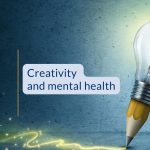When you were a young child, can you remember making fantasy worlds with Lego, banging on toy drums, playing out scenarios with dolls, and choosing your favourite colour crayons to draw animals, landscapes and stick figures? Creativity comes naturally to young children, but as we get older, our responsibilities and priorities change, and the impulse to be creative declines. This impulse is further suppressed by fear, which is one of the main obstacles to being creative. The fear of making a mistake, of being criticised, and not being good enough when we try to be creative. This is a shame, as being creative can be a key factor in promoting wellness and healing.
So, what is creativity, and how can it help you feel better? It’s a concept linked mainly to the arts these days, but it occurs in many different scenarios – cooking from scratch, coming up with a new idea to solve a problem at work, decorating your home, putting an outfit together, or designing your garden flower beds. These activities all involve a degree of creativity. It’s about using your imagination, making connections and bringing something new into existence.
Creativity can help your wellbeing in many ways.
- Expressing and processing feelings: Art therapy is the formal version of this, where a therapist helps you explore your emotions and work through them using creative methods. Outside of therapy, you can do this for yourself by putting feelings into words, images, movement or sounds. Something as simple and easy as dancing around your kitchen to rock music when you feel frustrated can ease tension, or writing a poem to describe feelings of sadness or scribbling shapes in brightly coloured pencils to release anxiety are all ways to help yourself when feelings get stuck. These methods of expressing and processing feelings can, eventually, also lead to self-discovery and a sense of inner calm.
- Boosting your ability to focus and concentrate: Creativity harnesses the power of mindfulness and being present. In the midst of composing and practising a piece of music, the focus will be on the actual playing of the instrument, listening to and keeping the beat and rhythm. When painting, you’ll need to be attentive to the colours being used, where you place the paintbrush on a canvas and decide the intensity of the brush strokes. Dancing or any physical movement means being in tune with what the body feels like doing at any moment. Being fully immersed in the present frees you from worrying about a theoretical future or ruminating over the past.
- Solving problems: If you’re struggling to make sense of a challenge in your life, or maybe you have a decision to make and are wondering which way to go, creativity can support you. One great way to do this is writing in a journal. This isn’t about jotting down what you got up to on a particular day but rather a stream of consciousness. Writing at least three pages in a notebook without stopping, worrying about grammar or spelling, or editing along the way. The physical act of writing helps to slow down your thinking and come up with new, uncensored ideas. If this way of writing doesn’t appeal, then try using a journal prompt. You can find lots of these on the internet, and you can also make up your own prompts, such as “If this problem was resolved, what would I be doing differently?” and then let your hand write out whatever comes up in response. You can also type your journal in a Word document if this works better for you.
Try to commit to one small act of creativity a day for a month and see what happens. If you start to feel anxious about being creative, remember that this isn’t about producing ‘perfect’ work; it’s about being curious and experimenting. There’s no need to judge or analyse your unique creative abilities; just try and see what works for you and helps you feel better.
If you find this article useful, please share it with others who may benefit from it.

